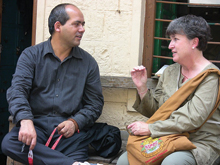People
October 13, 2010
Profound lessons learned in the presence of visionaries

Nancy Seideman is associate vice president for University Communications and executive editor of Emory Report.
After five years of immersion in the Emory-Tibet Science Initiative — from witnessing its inception to observing Emory faculty teaching monastics in India — I have learned what it means to be part of a university.
I have had the privilege of being in the presence of visionaries — not only the Dalai Lama and former Emory College Dean Bobby Paul — but all of the teachers, researchers, students, staff and monastics I have met along the way.
I have discovered that Tibetan Buddhist monastics are highly analytical and vigorous in their intellectual inquiry, creating a truly reciprocal relationship with our approach to scientific investigation. “And how do you know that?” is the constant question posed by monastics of the Emory faculty.
The medical journalist in me always wants the facts, the bottom line. In first writing about the initiative, I had difficulty in explaining what was meant by “bringing together the best of Western and Tibetan Buddhist intellectual traditions.”
I asked questions cautiously, embarrassed by my lack of knowledge, but then more boldly, encouraged by Emory faculty and Tibetan Buddhist scholars. I tried hard to get to “the answer,” particularly with Geshe Lobsang Tenzin Negi: “OK, so if this is true, then this follows, and this is the conclusion, right?”
“Well yes, but not exactly,” would invariably be his reply as Lobsang proceeded to give me an appreciation for what is meant by layers and layers of knowledge. I learned to remain still and listen.
I am humbled and moved when Tibetan Buddhist leaders and teachers unfailingly talk about the goal of creating new knowledge within the context of its ultimate purpose — to benefit humanity. In my everyday life, I had never thought of my work being connected to such an aspiration. I learned to make connections.
The environment is my passion. Sitting in a Dharamsala classroom with Emory faculty and monastics, I perked up when monastic and science student Geshe Sonam Dakpa talked about his concern regarding global warming and what he is trying to do as an individual to conserve resources (including, with mixed success, to convince his fellow monks to turn off the water when brushing their teeth). When he tells me that solicitude for global water issues has “seeped into his heart,” I am reminded of our shared humanity.
So when the Dalai Lama referred to the science initiative as a “100-year project” in my presence, I smiled but did not blink. That’s another thing I learned from my Emory and Tibetan Buddhist colleagues and friends — to take the long view.
